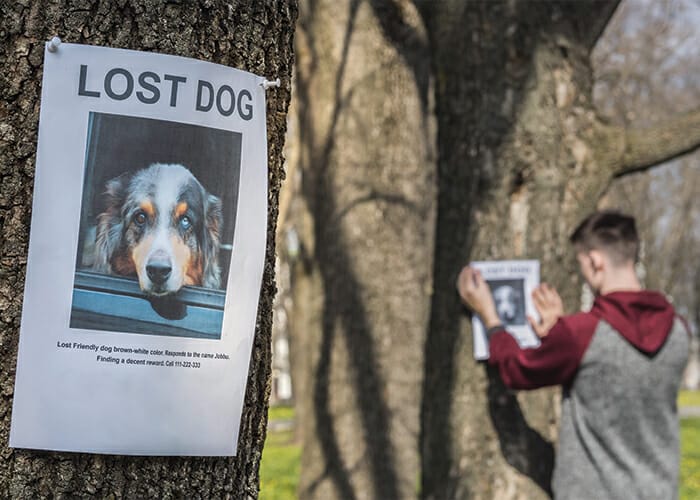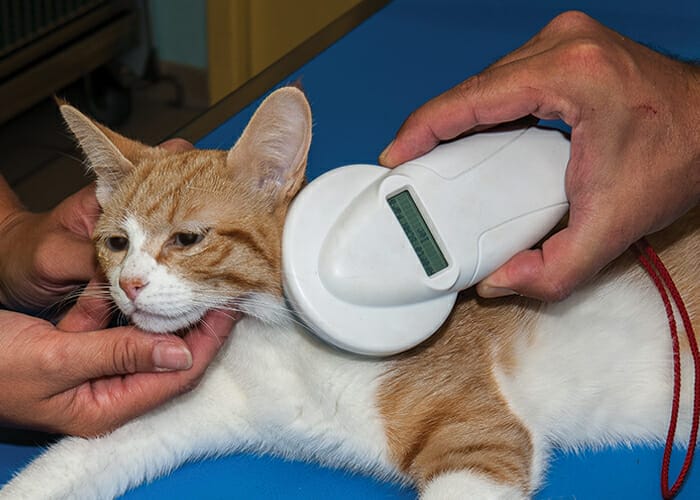
According to the American Humane Society, approximately 10 million pets are lost each year in the United States. Most commonly, this occurs when a pet gets out of their collar, off leash, or out of their home, crate, or yard. These situations can occur at any time and to anyone; even the most vigilant pet owners and pet professionals. Fortunately, you can increase the odds of reuniting with your pet by doubling down on safety and pet identification. Make sure your pet has an appropriately-fitted collar, physical ID tags, and a microchip.
ID Tags for Pet Identification
The simplest and fastest way for someone who finds a lost pet to contact you is by looking at your pet’s collar and ID tags. Be sure the tag includes the most essential information:
- Pet’s name
- One to two phone numbers (with area code)
- City and state or complete address
- Optional information such as “I’m microchipped” or “I’m deaf”
The collar should also include a current rabies tag and your county/city license. These tags help someone identify that your pet is not a stray animal and is up to date on their vaccinations.
If you move or get a new phone number, be sure to update your pet’s tags. If you are traveling, you may consider adding a temporary tag with your pets sitter’s contact information.
There are several types of ID tags:
- Engraved ID tags are readily available through a variety of retailers. These can include your pet’s name, your name, and contact number. Space is limited on this type of tag and the engraving may wear off over time.
- Personalized collars that include their name and your phone number can be made.
- Another option is a digital ID tag. These can be scanned using a smartphone and bring up an online profile. This approach gives you an opportunity to include things like additional contact numbers or health information.

Microchipping for Pet Identification
The biggest benefits to microchips are that they are permanent, they can’t be lost, and they can’t be tampered with. Pets can lose a collar or ID tag, or someone can remove them. But chips are there to stay, and they have been found to be effective.
According to a study in the Journal of the American Veterinary Medical Association, dogs without chips make it home 22% of the time. However, that number jumps to more than 52% when they have a chip. For cats, the number for those returning home without chips is a mere 2%. But that jumps to about 38% when cats have a chip. Dogs found as far as 1,000 miles away from their home were reunited with their families thanks to microchips. The microchip process is simple, affordable, and beneficial.
How does a microchip work?
Microchips are small electronic devices encapsulated in glass. They are only about the size of a grain of rice. The microchip includes a small antenna that is activated when someone scans it. The scanner emits a radio wave that picks up the chip’s information. The scan provides an identification number which is then searched in the manufacturer’s microchip registry database.
How does my pet get a chip?
Your family veterinarian injects the microchip just under your pet’s skin using a hypodermic needle. It is a quick and relatively painless procedure that feels like getting a shot. It is typically implanted between the shoulder blades. Microchips should be placed by a veterinarian or under a veterinarian’s supervision. When implanted correctly, there is little chance of complications. If you notice any abnormalities such as drainage or swelling, you should contact your veterinarian.
What happens after my vet implants the chip?
Getting the microchip in place is only the first step. You must also register the microchip into the manufacturer’s database. This is the only way to trace your pet back to you! When a shelter or veterinarian scans your pet, they’ll input the chip number into the database to match them to you. If you did not register or your information is out of date, it won’t bring up a match.
There is not any ongoing maintenance needed for the chip. However, if you move or get a new phone number, you need to remember to update your registry information. You should also ask your veterinarian to check the chip during your pet’s annual checkup to make sure it’s still in place and working.

Could there be adverse reactions?
Of the more than 4 million chipped pets that have been tracked by the British Small Animal Veterinary Association since 1996, only 391 adverse reactions have been noted. The majority of those are from the microchip moving from its initial spot. Other reactions have included chip failure, hair loss, allergic reaction, swelling, and tumor formation. Those complications were reported in much lower numbers.
The benefits of being able to find your pet far outweigh any potential risks. The American Veterinary Medical Association, American Animal Hospital Association, World Small Animal Veterinary Medical Association, and the American Society for the Prevention of Cruelty to Animals all endorse using microchips in pets.
Does a microchip always work?
Microchips are not 100% perfect, and there is no guarantee that you will be reunited. In some pets, the chip may move from its original placement over time. This is not usually a cause for concern from a medical standpoint. However, it can make it more difficult for a shelter or veterinarian to find the chip during a scan.
Because of the different types of scanners and frequencies used in chips, there is a small chance the scanner being used does not read your pet’s chip frequency. However, many locations now have universal scanners that can pick up the various frequencies used by current microchips. Other scanning issues can result from an uncooperative pet not holding still, matted hair or fatty tissue in the way, or if there’s too much metal on a collar. Veterinarians and shelters are aware of these potential issues. They are trained to perform thorough scans so that they are less likely to miss a chip.
Proactively Protect Your Pet
No one wants to think about losing a beloved family member, but accidents can happen. Ensuring your pet has accurate identification is an important step to bring your pet home safely should they become lost. A combination of physical identification and microchipping gives you the best chance at reuniting with your pet. Finally, always make sure you update tags and registration if you move or get a new phone number. You’ll be glad you took those extra precautions if your furry friend ever goes missing.
Sources:
https://www.avma.org/resources-tools/animal-health-and-welfare/microchipping-animals